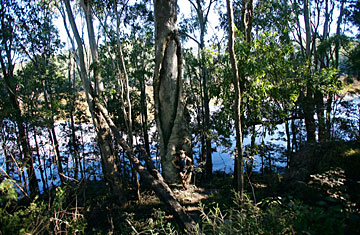
The bark cut from this tree was probably used to make a canoe, says local historian Matthew
As a bush botanist, Patrick Matthew sees the river that snakes in and around the tiny New South Wales township of Wiseman's Ferry as a living thing, freshened by the Macdonald River that intersects it from the north, and flushed by seawater from Broken Bay, 40 km to the east. "When the tide comes in, it's slightly salty," he says. "If you go swimming you can taste a bit of salt on your lips."
As an award-winning novelist, Kate Grenville sees the Sydney-skirting Hawkesbury in more symbolic terms. And having completed her Master's in creative writing at the University of Colorado in the early '80s, the Balmain-based writer is not immune to the poetic possibilities offered by rivers in such literary classics as Mark Twain's The Adventures of Huckleberry Finn. For Grenville, a river is "a way of penetrating a land that might otherwise be opaque to you," she says. "It's like this little track into the heart of a secret."
In her masterful novel The Secret River (Text), winner of the 2006 Commonwealth Writers' Prize, Grenville cuts through swathes of history and myth to arrive at a place that is, artistically at least, true. Her subject is a small section of the Hawkesbury, perhaps half a kilometer long, edged by soaring sandstone cliffs and fuzzy gray-green foliage. "The river revealed itself, teasingly," she writes, "never more than a bend at a time, calm between its walls of rock and bush." Its story, too, evolved slowly. For at least 15,000 years, the Darug Aborigines would gather to feast on the yam daisies that grew abundantly along the banks. And it was here, around the turn of the 19th century, that European settlers like the original ferryman, Solomon Wiseman, came with dreams of growing rich on the river trade that carried produce between Sydney and Newcastle.
Having come to the nearby Dharug National Park to write a botany thesis nearly 40 years ago, Patrick Matthew — with his bushy beard, blue singlet and bare feet — is as familiar around Wiseman's Ferry as the Aboriginal rock engravings that scatter this area of the Hawkesbury. There are thought to be around 400 such sites, and Matthew knows most of their locations by heart. Less resilient have been the yam daisies of Wiseman's Ferry. "That's where they all grew," he says, pointing to a part of the riverbank now dotted with poplars, "and that's where the white fellas took over, didn't they? So there would have been a direct conflict for food." Grenville agrees: "The very reasons why Wiseman settled here are the same reasons why the Aborigines would have been living here," she says. Grenville likens this segment of the river to a human thumb — "it's the shape of my thumb, anyway," she says with a laugh. Her view of the river, too, is stamped with personal history. Solomon Wiseman was her great-great-great grandfather.
Just down the hill from the Wiseman's Ferry Inn, built as his grand colonial residence Cobham Hall, Solomon Wiseman's life-sized bronze statue stands in tailcoat and breeches, the perfect picture of a self-made man. "One of the family stories is that he was buried in a tail coat like that with a top hat on," Grenville recalls. "Because he was so much not a gentleman, he obviously wanted to pretend he was." The statue's plaque calls him "pioneer, inn-keeper, ferry-master." But there is a slight frown to his brow that lends an ambivalence to his air of triumph. He is, of course, the inspiration for The Secret River's warts-and-all emancipist, William Thornhill, who, like Wiseman, rose from the slums of Bermondsey to become a lighterman on the Thames before being transported to Australia for stealing six pieces of Brazil timber. Once in Sydney, he followed a similar path to Wiseman's: both received a ticket of leave and pardon, and began trading along the Hawkesbury, which Governor Arthur Phillip had named after the English statesman Charles Jenkinson, 1st Earl of Liverpool, Baron Hawkesbury of Hawkesbury.
Grenville had set out to write a memoir about her enigmatic ancestor, but with years of research taking her from Old Bailey transcripts to the Governor's dispatches, she quickly began losing sight of the story's Hawkesbury heart. "I had to make the connection: his life, my life, and the place where they came together," she writes in her book about the writing of her novel, Searching for the Secret River (Text). Which is what got her back to the yam daisies of the riverbank.